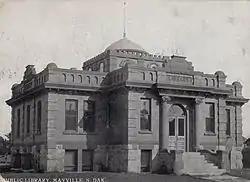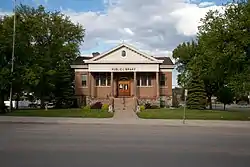William C. Albrant
William Colston Albrant (24 June 1871- 3 August 1905)[1] was an American architect practicing in Fargo, North Dakota.
William Colston Albrant | |
|---|---|
| Born | June 24, 1871 |
| Died | August 3, 1905 (aged 34) Fargo, N.D |
| Nationality | American |
| Occupation | Architect |

Biography
Albrant was born in Winchester, Ontario in 1871. In 1895 he moved west, planning to make his way as a farmer. However, later that year he enrolled in the Division of Mechanical Arts of the North Dakota Agricultural College at Fargo.
By December 1897 he had established his own architectural office in Fargo.[2] He practiced until his unexpected death at the age of 34 in 1905.
After his death his office was managed by William D. Gillespie, Albrant's younger brother-in-law, and became W. C. Albrant & Company.[3] Gillespie advertised for an associate to manage the firm, and it was reorganized as R. J. Haxby & Company in March 1906.[4]
Despite his short career Albrant designed several major North Dakota buildings, including the state's first purpose-built public library, in Mayville. Several of his buildings are listed on the U.S. National Register of Historic Places.[5]
Works
- Kindred State Bank Building, 411 Elm St., Kindred, North Dakota (1900)[6]
- Mayville Public Library, 52 Center Ave. N., Mayville, North Dakota (1900)[5]
- Union Block and Lura Building, 21-29 W. Main St., Mayville, North Dakota (1900)[5]
- Union Block, 3-9 N. Main St., Hillsboro, North Dakota (1900)[7]
- Minard Hall, North Dakota Agricultural College, Fargo, North Dakota (1901)[8]
- Jacobson Block (Opera House), 2 Main St. N., Minot, North Dakota (1902) - Burned 1923.[9]
- Robb-Lawrence Building, 650 Northern Pacific Ave., Fargo, North Dakota (1903) - Possibly inspired by nearby work of Cass Gilbert.[1][10]
- Valley City Public Library, 413 Central Ave., Valley City, North Dakota (1903)
- Carnegie Library (Putnam Hall), North Dakota Agricultural College, Fargo, North Dakota (1904–05)[11]
- First Baptist Church, 720 1st Ave. S., Fargo, North Dakota (1904) - Demolished.[10]
- Milroy Public School, Milroy, Minnesota (1904–05) - Demolished.[12]
- Moose Jaw City Hall, Fairford St. W., Moose Jaw, Saskatchewan (1904–05) - Demolished.[13]
- Phillips Academy, New Rockford, North Dakota (1904–05) - Demolished.[14]
- Sykeston Public School, B St., Sykeston, North Dakota (1904) - Demolished.[15]
- Old Main (Expansion), Mayville State Normal School, Mayville, North Dakota (1905)[16]
- Y. M. C. A. Building, 630 1st Ave. N., Fargo, North Dakota (1905) - Demolished.[17]
References
- "Albrant, William Colstrand". Biographical Dictionary of Architects in Canada.
- Improvement Bulletin 4 Dec. 1897: 10.
- Improvement Bulletin 17 Feb. 1906.
- Martens, Steve C. and Ronald H. L. M. Ramsay. Buildings of North Dakota. 2015.
- "National Register Information System". National Register of Historic Places. National Park Service. July 9, 2010.
- Improvement Bulletin 26 May 1900: 16.
- Improvement Bulletin 14 April 1900: 16.
- North Dakota State University District NRHP Nomination. 1986.
- Commercial West 21 June 1902: 30.
- Roberts, Norene A. Downtown Fargo District NRHP Nominationand photos. 1982.
- North Dakota State University District NRHP Nomination. 1986.
- School Board Journal Sept. 1904: 22.
- Engineering News 18 Aug. 1904: 79.
- School Board Journal April 1904: 27.
- School Board Journal July 1904: 27.
- History of the Red River Valley: Past and Present. Vol. 1. 1909.
- Improvement Bulletin 8 July 1905: 21.

